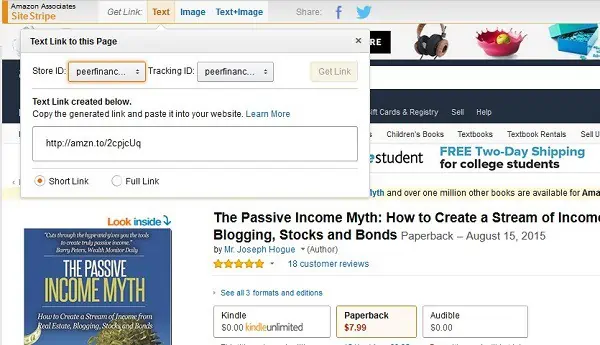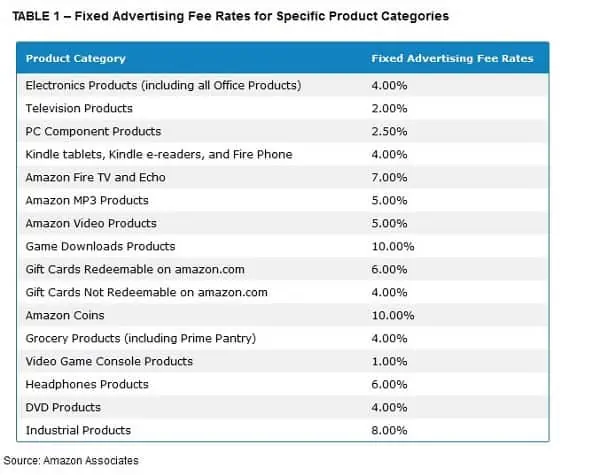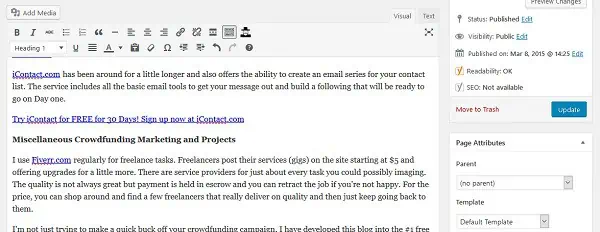Use this guide to build the affiliate marketing income stream on your blog and make more money
This guide to affiliate marketing for bloggers is the first in a series I’m planning on running over the next few months. I’ll be covering 11 of the best ways bloggers make money including things that make money right away and strategies that take longer but can make more money than you’ll believe.
Affiliate marketing has saved my butt more than a few times with my blogging income. It was one of the first revenue streams I implemented and the first to make serious money.
We’ll cover everything affiliate here including my process for affiliate marketing, how much you can make and how to do affiliate marketing without seeming spammy.
It’s a long post so you might want to bookmark it to review later. Be sure to ask any questions in the comments or share your affiliate marketing secrets.

Don’t miss the rest of the book and your chance for financial independence! Just $3.99 on Kindle could change your life!
Let’s get started!
What is Affiliate Marketing
Affiliate marketing is a form of advertising on your blog. You place a link or a banner to a product on the site or in an article. If someone clicks through the advertisement and buys the product, you receive a commission.
That’s different from how you make money with other types of advertising like with Google Adsense. In Pay-per-Click (PPC) ads, you only need someone to click on a link or banner to get paid.
With affiliate marketing, you might have hundreds of people click on the link before anyone actually buys the product and you might need hundreds of people to see the link for every five or ten clicks.
The upside is that affiliate marketing pays much more for each commission. You’ll get anywhere from a couple of bucks to hundreds when you make an affiliate sale.
Advertisers like affiliate sales because they only pay when someone buys their product. It can save a lot of money versus throwing funds at Google Adwords and the PPC model.
Bloggers like affiliate marketing because it can lead to a lot more money if they promote the right affiliates. You also don’t have to create your own products to start making money. When someone clicks on your link, a code (cookie) is placed on their computer. The cookie can last from a few days to months, depending on the advertiser, and you get credit for any purchases made during that time.
We’ll go into the complete How-To process of how to start making money below. The easiest way is to join affiliate networks, middle-man websites that work with advertisers. You create an account and can apply to advertise hundreds of affiliates. You get all your links from the one place and get all your commissions in one check.
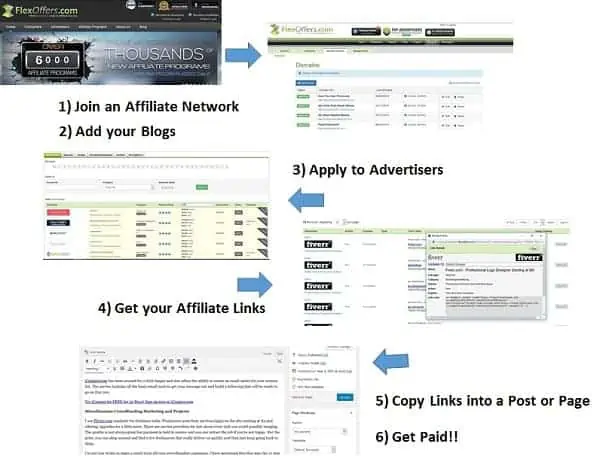
How Much Money Can You Make with Affiliates
We’ll get to the affiliate marketing process in a bit. First, I want to talk through how much you can expect to make with affiliates on your blog.
If you haven’t setup your blog yet, check out this special offer from Bluehost. It’s the most popular WordPress hosting provider and one of the easiest to use.
I make just over a grand each month from affiliates on my blogs, about a third of my total income. That’s really only on two of my blogs since the other four are still fairly new and I’m still building traffic to the point where affiliate sales are higher.
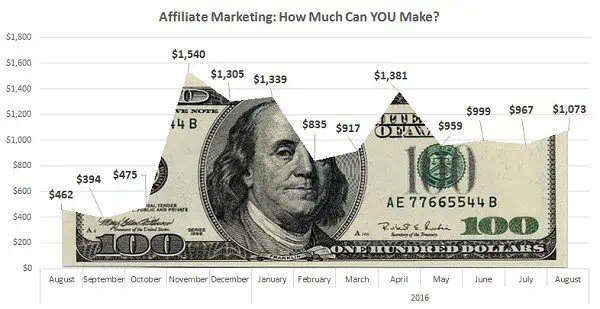
Notice the big spike in November and gradual decline to February in the chart. This is called seasonality and it’s a factor in affiliate marketing. It will be different for some affiliates but most see higher sales before and during the holidays while activity trails off during the spring and summer.
That’s a problem in a lot of blogging income streams. People are less inclined to buy stuff, take courses, ask for consulting or do just about anything during the summer. There are two ways to approach it:
- Don’t worry about it. The money you make on affiliate marketing will grow each year as your blog grows. Some months will be lower but the trend will be upwards. Enjoy the good months and put a little extra in savings.
- Diversify by signing up for affiliate programs that do well in spring and summer months (i.e. gift ideas around Mothers’ and Fathers’ Day, summer travel, etc). Advertising has to be natural to your topic but the more affiliates you talk about, the more likely you are to build a consistent income stream.
I’ve balanced my affiliate sales with other income streams so not all my posts are monetized through an affiliate link. If you focus more directly on affiliates, you can make a lot more each month.
Rakuten Marketing released a survey earlier this year with publishers reporting making more than 20% of their total website income from affiliates.
I know bloggers that make tens of thousands a month on affiliate sales…yes, that’s $10,000+ in a single month. There’s no secret to it. Just a simple process outlined below and the website traffic to get clicks.
It’s not just how much you can make with affiliate marketing but the ease at which you do it. While some of the other blogging income streams require hours spent on writing, course creation or other services, affiliate marketing takes almost no time to put links in your articles. Even better, there is almost no upkeep – you’ll continue to make passive income from affiliate links on old posts.
The same Rakuten survey projects affiliate marketing sales to grow at an annual rate of 10% through 2020 to $6.8 billion. That’s just over the expected growth rate for all online sales and way over the 4% growth expected in traditional store retail sales.
If you have a blog…you need to be taking advantage of affiliate marketing as an income stream!
Joining Affiliate Networks for Blogging Income
There are a few different ways to promote affiliate marketing on your blog. The most common is by joining affiliate networks to find advertisers.
These affiliate networks seek out and negotiate with advertisers on their programs. You create an account on the network and search for advertisers within different categories.
You usually need to apply for each advertiser’s affiliate program so it’s a good idea to search through and apply for all the ones you might be interested in joining before you need the links.
Each advertiser on the network will have rules to their program, where you may use the links and what is prohibited. These are generally the same for most advertisers and include things like not bidding on Google Adsense keywords around the advertiser’s branded name.
Each advertiser will also disclose how much money you make on each sale, either a commission rate or a flat fee. Also disclosed will be the cookie duration, the amount of time during which you will get credit for a sale made by someone that clicks through your link. I’ve seen these as low as a few days and as long as 60-days.
Along with your account, you will input your payment information. Most affiliate networks offer electronic deposits into your checking account. You will generally be paid on a monthly basis, usually for the previous month sales.
Some affiliate networks to check out:
ShareaSale – One of the longest-running and largest affiliate networks with more than 16 years in affiliate marketing
CJ Affiliates – Formerly Commission Junction and my top affiliate network
Flexoffers – A bit smaller than the other networks and with limited reporting but still worth the time
LinkShare (Rakuten) – Bills itself as the #1 affiliate marketing network…though I’m not sure how they measure it. Lots of advertisers and an easy dashboard.
You can join more than one affiliate network. In fact, I have an account on all four networks above. It doesn’t cost anything to join and being on more than one network gives you a greater range of advertisers to promote.
If you run multiple blogs, you will need to add each to your affiliate network accounts. When you go to copy the links for an advertiser to promote on a blog, you will need to make sure you are using the link approved for the specific blog. We’ll cover this more in detail later.
Joining Amazon Associates Affiliate Program
Amazon has its own affiliate program that you will also want to join called Amazon Associates. You can create one account for all your blogs and do not have to use separate links for the same product when posting on different websites.
Amazon makes it extremely easy to get links and promote products on your blog. These easiest way is directly from the website but you can also use the Amazon Associates site to search for links.
The downside to Amazon Associates affiliate marketing is the terms and payout on sales. You only get credit for a purchase if a reader buys something within one day of clicking on your link. If they add the product to their shopping cart then you get credit if they buy the item within 90-days but otherwise, it’s the shortest cookie duration I’ve seen anywhere.
The other downside is the payout, ranging from just 2% of sales on televisions to 10% on game downloads and coins. Even the 10% rate is pitifully low compared to most affiliate marketing advertisers that offer commissions as high as 70% on their products.
For products not listed in the chart, your commission starts at 4% and is adjusted higher depending on the number of items shipped in any given month. These rates suck but you can still make money with Amazon affiliate marketing.
You will earn a commission when someone clicks on your Amazon Associates link but then buys something else on the site. Most of your readers are going to be fairly comfortable buying on Amazon so you do not have to get over that ‘brand awareness’ hurdle that you might with other affiliate advertisers.
I’ve found reviews and list comparisons work well for selling Amazon products. One example is a ‘best books’ list I run each year for each blog.
- Pick a fairly narrow keyword like ‘best investing books’ for which you think you can rank on Google. This is important because it will send you consistent traffic each month to the post.
- Look for ten or more products within the topic, i.e. books you have read or popular books within the theme.
- Provide a one or two paragraph description of the product, who should use it and how it stacks up against the group of products. Include an image of the product in your post and tag both the name of the product in the description and the image with your affiliate link.
I’ve used this idea for book lists, comparing electronics in a theme and in a cord-cutting article. It isn’t a big chunk of blogging income each month, around $50 currently, but it is passive income and articles generate clicks for years after they are written.
Direct Affiliates on Products You Use
Some companies don’t work through affiliate networks but run their own program through their website. It’s more common with individuals selling their own course or product but I’ve seen larger companies manage their own program as well.
The process to sign up and make money on direct affiliates is the same as working through a network. The only difference is that you only have the one product to promote from that account.
If you use a product and would like to promote it, search Google for ‘[company name] affiliate program’ or look on the company’s website at the bottom of the page.
I have done direct affiliates with a few other bloggers and their courses but don’t promote direct affiliates as much as I do those on the affiliate networks. You generally don’t get as much reporting with direct affiliates so you may not know how many impressions or clicks you get from the links. Working with the individual companies for just one affiliate product is a pain as well compared to the larger networks.
If the product or course is something you really love and think your readers will too, go ahead and sign up for the affiliate program. Otherwise, I would stick with the affiliate networks and Amazon. They have more products than you’ll ever be able to promote and make it convenient to get all your links in one place.
How to Make Money Blogging with Affiliates
So we’re finally through the introductory material on making money with affiliate marketing. Yay! Now we can get to the actual process I’ve used to make over a grand a month with blog affiliates.
Some points to keep in mind before you get started with affiliate marketing on your blogs:
- Don’t burn your readers with bad products. Wonder why affiliates offer such juicy commissions on each sale? Because it’s tough (and expensive) to get new customers. The same thing goes for blog followers. Make a habit of pushing shoddy products just because they offer an affiliate payout and you’ll see your blog traffic suffer.
- Stay close to your blog topic for affiliate products. Most blogs attract a specific type of visitor, someone looking for a specific topic whether its investing advice, personal finance tips or how to cook a soufflé. Pushing a bunch of unrelated products, i.e. the hot new smartphone on your cooking blog, isn’t going to be effective. There are plenty of affiliate products available in any niche. Spend your time reviewing and talking about those and you’ll make more money in less time.
- Focus on Trust and Relationships. Success with affiliate marketing is all about trust. If your readers feel they know you and can trust your recommendations, you’ll make boatloads of money. If you write in an impersonal, sales-y way to push products…you’ll just be ignored like any other commercial.
- Create a Resource Page. You should have a page on your site, highlighted in the menu, that shares all your best affiliate recommendations. Write up a paragraph for each affiliate and link any related articles or reviews as well as posting your affiliate link.
- Banner Ads Suck! Readers just don’t click on banner ads that much. I use them sparingly in the sidebar on my blogs but not much elsewhere. A text link is much more effective and seems less intrusive to readers.
Once you’ve created your account on a bog network, you need to add your domains and payment information. You’ll need an address, SSN or business EIN, checking account number and the routing number for your bank to set up electronic payments.
For each blog on which you want to place links; you’ll need to fill in the domain address, some information on visitors, blog niche and a short description about the site.
Once you’ve got your account set up and domains added, you can start applying for affiliate programs. Just to clarify…one blog network contracts with thousands of companies wanting to sell their products. Each company offers publishers (bloggers) a commission and terms on their program. As a blogger, it’s your job to search through the affiliates on the blog network to find the best to work with and promote.
So the question becomes…which affiliate products should I promote on my blog?
We’ve already hit on relevancy for your blog. You aren’t going to make many affiliate sales for sports equipment on your investing blog. Writing reviews about or promoting products unrelated to your blog topic will annoy visitors and confuse Google when it comes to ranking your site.
Here’s four more ways to find affiliate programs to promote on your blog.
- Products or services you already use. Think through the processes you talk about in some of your blog posts. If it’s a cooking blog, what cookware do you use? What equipment or appliances do you use? Promoting products that you already use is going to go a long way to make affiliate sales based on that idea of trust.
- Check out other blogs in your niche. Most blogs will have a resource page and reviews (search for ‘review’ if you can’t find them). Look at the links on these pages. If the link looks like a jumbled mess then it’s an affiliate link. If the link is the website URL plus the name of the product then it’s probably also an affiliate. You could always click through the link as well. If it goes straight to the product’s sales page, it’s an affiliate.
- Check out other blogger’s income reports if they post them. Some will talk about their best affiliates and even detail how much they made during the month.
- The affiliate networks listed above all have easy category search systems. Scroll through some of the categories that look applicable to your blog niche. When deciding whether to apply for an affiliate program, I look at two things:
- What is the affiliates three-month earnings per hundred clicks (EPC)? This is the average earnings other bloggers have booked.
- How long is the cookie duration? I like to see at least a 30-day cookie duration on an affiliate program. That means someone can click on my link, look over the offer but then has up to 30-days to make a purchase and I’ll still get credit. If a reader has to make a buy decision immediately for me to get credit…I’ll probably pass.

Click ‘Apply’ and agree to the terms of service on the affiliate programs you want to join. Don’t feel like you have to join hundreds of programs. I’ve collected sales on 26 affiliate programs but just seven of them account for 95% of my total affiliate income.
There’s an important message there so let’s repeat it. A handful of affiliates will probably account for the vast majority of your sales. They are going to be a few affiliates that are really helpful to your blog’s core market. Find out who that market is and what they need and you’ll strike affiliate gold!
These best affiliate programs are probably going to be the products and services which you use and trust the most. You’ll be most enthusiastic and informed about these products and readers will pick up on that.
One of my best performing affiliates is Motif Investing, an investing platform that lets you group up to 30 stocks and then buy them all with one commission. As an investor and investment analyst of more than a decade, I’ve never seen anything like it and I’ve moved much of my own money to the platform to save money and help find the best types of investments and stocks. That’s a huge vote of confidence in the service and a lot of readers have followed me to the site.
Putting Affiliate Marketing Links on Your Blog
It will take up to a week for your applications to affiliate programs to be approved. This is why you should apply early and not the day before you want to post a great affiliate review on your blog.
Once approved, you’ll be able to go into the affiliate network and get links or banners to put on your blog. This html code will redirect visitors to the affiliate program’s website when it’s clicked but also has a special part that make sure the company knows that customer came from your blog.
Most affiliate programs will have many text links and banners from which to choose. The text links will display the product or company name or up to a sentence of text that will be underlined and linked on your blog. Banner ads will also be html code but will show up as a clickable image on your site.
Some affiliate networks allow you to sort links by the highest earnings over a period. This is helpful in seeing which have converted best either because of persuasive text or a strong landing page where the link redirects. Click through the link to see where it redirects and if you think it would convert well with your readers.
When you’ve found a link you like, you can copy/paste the code onto a document with all your affiliate codes for reference. You are going to be promoting the affiliate often and on different posts so having a document with all your codes makes it easier than going back to the affiliate network for every post.
Again, I run very few banner ads on my sites because they just don’t convert very well to sales. Your experience may be different so do some testing over a few months.
- Best places to try banner ads will be in your header, in the upper-right next to your logo, and within your sidebar. Generally the best banner sizes that fit here and convert well are the 728×90 rectangle for the header and the 300×600 or 336×280 rectangle ads in your sidebar. I will also use the slightly smaller 300×250 box-size in the side bar just to save space for content links.
- Test out a few different banner sizes and positions for your top-producing affiliate programs. It will take a few months to figure out exactly which these are and then several more months of testing.
- The affiliate networks will show you from which links you are getting clicks and sales so you will be able to see which banners are converting best.
- You can also place banner affiliate ads on pages or within individual posts. These convert best when they are around content related to the product, otherwise it’s just a random commercial.
Affiliate links should appear natural in your blog posts or pages. This means making it look less like a commercial and more like a recommendation.
- Writing your article, link the first or second reference of the product company with your affiliate code. Either use one of the affiliate text links with the company/product name or the PrettyLink software I talk about below.
- I usually include one or two callouts as well. These are short, one-sentence calls to action that are linked. Something like, “Click here for…” or “Get this special offer from…” You’ll find some of the best callouts are provided as text links on the affiliate network platform.
- You want one callout fairly soon in the article and one within the last few paragraphs. This catches the people that don’t read the whole posts and those that stick around for all the info.
- Using your affiliate link code in WordPress is easy. Click the ‘Text’ tab in the upper-right corner of your content manager to see the html version of your post. Paste your affiliate code where you want it to appear in the article.
The Federal Trade Commission (FTC) requires advertisers to notify readers about paid arrangements like affiliate advertising. This is usually with a simple sentence like, “This post contains affiliate links,” somewhere on the page. Some advertisers and affiliate networks are starting to require the disclosure at the top of the page in plain site rather than hidden elsewhere.
The Best Affiliate Marketing Plugin to Make Life Simpler
Two huge pains in the neck for affiliate bloggers is managing all the link codes for affiliate programs and managing the links on their websites.
- You might have many link codes for each affiliate depending on what you want the text content to say. Going to the affiliate network dashboard or even to your link codes document every time you write a post is a nuisance. Over years of blogging, you might refer to a specific affiliate product hundreds of times in posts, reviews and pages. That is a lot of individual links to manage.
- Affiliate programs are constantly being paused, deactivated and then reactivated. You’ll get emails from the affiliate network that a program has lapsed. You rush in to change the affiliate links in your posts because those programs are no longer paying…and then you get an email that the program has been reactivated. It happens a lot.
One plugin helps you manage both of these problems and it’s extremely popular among bloggers. In fact, anytime you see a product mention on a site and the link URL looks like http://[blogger’s website URL]/[product name] – it’s probably this plugin working.
The plugin is called Pretty Links. It offers a few other features but the real power is in managing your affiliate links. By pasting in your affiliate link code in the ‘Target URL’ and then typing the affiliate program name or product in the ‘Pretty Link’ box, you create a single link you can use for every time you refer to an affiliate.
Whenever you want to link to an affiliate in a post, you just link to that new ‘Pretty Link’ instead of using your link code. You can link any text you want including the product name or a callout sentence.
As the name implies, the plugin also lets you change the URL link from a jumbled, messy affiliate code to something that looks more professional. Readers are hesitant about clicking on a link if they thing it will take them to http://www.jdoqocy.com/click-7903277-11204587-1455624628000 but will click on a link that looks like it redirects to a page on your website.
If the links for an affiliate program are ever changed or the program is deactivated on the affiliate network, all you have to do is go back and change the ‘Target URL’ box to redirect all the instances of that link to a new website.
The Pretty Link plugin also lets you automatically NoFollow links so you don’t get in trouble with Google. The plugin tracks how many clicks you get on a link and you can download a spreadsheet showing when you got the clicks and from posts to really track your affiliate efforts.
The Pretty Link plugin comes in two prices, one allowing you to use on one website and another allowing you to use on unlimited websites. Both plans offer special training material, lifetime automatic updates and premium support. I use the Developer Edition ($97) since I need to use it on my six websites. The Blogger Edition is cheaper ($47) but you’re limited if you ever want to use it on another site.
Click to check out the full list of Pretty Link features
9 Affiliate Marketing Blogging Strategies
Here are some of my favorite affiliate marketing strategies to use on a blog, in order of effectiveness. You will need to check the affiliate permissions for some of them. Some affiliate advertisers do not allow sharing their links directly on social media, though linking to an article that includes an affiliate link is always allowed. Others prohibit email advertising or search advertising. This is why it’s important to keep a spreadsheet of your affiliates along with any special rules so you don’t have to continuously login to the affiliate network.

- Go to Google Analytics then to Behavior – Site Content – All Pages in the left-hand menu. This will give you a list of the most popular posts or pages on your blog over the last month or whatever time period you set.
- Work your way down the list, looking for any natural product mentions you can make in each post. You’ll want to do this with all the posts on your blog but starting with these most popular articles will get you making money faster.
- Don’t force an affiliate product into a post but there is usually at least one product or service you can recommend in every post. If you’re having trouble, go back to search the categories on the affiliate networks.
- Add at least a paragraph leading in to the recommendation along with your affiliate link and update the posts. The higher up you can add the link on the page, the more people will see it and the more money you’ll make.
2) My best performing affiliate posts are long comparison guides. These are super-long articles listing out different products or services for a specific need, i.e. Best Online Loan Platforms for Bad Credit. Set up the article with a brief introduction and then launch into two or three paragraphs on each product. Include an image of each as well as special features and promotions.
These comparison posts work great for a couple of reasons. First, the length and detail generally do very well on Google. One of my comparison posts is nearly 4,000 words long and the most popular article on the blog because of all the Google traffic it gets. These posts also work because they give readers a choice. It’s less about an individual product and more about helping the reader find a solution to their need.
3) Individual reviews of affiliate products tend to also do well. These are an entire article focusing on one product and the need it solves. Be honest and share what you didn’t like about the product as well. Talk about who specifically the product is best for and who might find a better option in another choice. Is it the low-cost option or better for one particular type of customer?
Individual reviews tend to do well because they can rank better on Google. You might have a hard time ranking a comparison post around a general keyword but add in the product name and you narrow search competition down significantly. You also get people that are looking at that specific product and might be further along in the buying decision.
It’s important here to talk about buyer intent and mood and how it relates to affiliate success. When you’re writing a review or comparison, try optimizing for keywords that attract search visitors close to the final purchase decision.
Before someone makes a purchase, they go through a decision process. First they have to realize they need something, even if it’s on a subconscious-level. Then they look for information about products or services before evaluating the alternatives. This process may happen very quickly for impulse purchases or slowly and methodically for other purchases.
The idea is to optimize your affiliate articles for keywords around the last stages of buyer decision, when someone has the intent to buy and just needs to make a choice on a specific product.

4) Offer a bonus along with the affiliate product. This could be a short guide on how to get the most out of it or other special tips. Make sure the bonus material is complementary and allowed under the affiliates terms. You can distribute the bonus material through email automatically when the reader signs up to your landing page or require them to email you their purchase confirmation.
Great types of bonus material that convert to affiliate sales include:
- Add-ons to the product
- Video tutorials on YouTube or your own site
- Quick start guides and How-To
5) Promote your comparison posts and affiliate reviews through social media as you would any other post. Some affiliates will also allow you to link directly to their site from your social media posts. These do not generally convert very well and may lead to a few ‘unfollows’ so I only use them for special offers.
As someone signed up for a company’s affiliate program, you will occasionally receive emails about a limited-time or special price offer. Promoting these through social media work best and don’t usually peeve readers off.
6) Consider dropping your affiliate links in your blogroll or a sidebar list if the affiliate has a blog or other resource for readers. These simple lists don’t generally lead to much unless you’ve got a large traffic base but it’s easy to put together and you’ve already got a blogroll page anyway.
7) Put affiliate recommendations in your emails and newsletters. Trust is the biggest hurdle to overcome in affiliate marketing. Readers need to trust you and the recommendation to actually click through and buy the product. You’re already halfway there with your email subscribers who presumably trust you to a point or they wouldn’t have signed up for your list.
This can be done through referring subscribers directly to the affiliate through your link or just suggesting your review post and linking back to your blog.
8) Banner Ads still can get you some affiliate sales even though it can take over 300 visitors to get just one click…and then 100 clicks to get a sale. Good banner ad positions are up in your website header, to the right of your logo, and in your sidebar. These will show on every page so you’ll get lots of impressions and maybe a few clicks. Include text content like your most popular posts and a list of your product reviews in the sidebar as well so it doesn’t look like one big commercial.
3 Blogging Affiliate Marketing Rules To Live By
A few pointers beyond what we’ve already covered. Some are repeats from what I talked about in the affiliate marketing process but are important enough to be added here as well.
- Remember what your mother said, “If you don’t have anything nice to say…” You need to be honest about an affiliate product but just don’t talk about the affiliate if all you have to say is bad. You won’t get any sales anyway and I know one blogger that has been sued multiple times because he posted borderline disparaging comments about a few products.
- Link images with your affiliate link. Include an image of the product or service next to the content link for your affiliate. Go to Edit on the image details and the Link To drop-down box for Custom URL. This will allow you to paste in your affiliate link so a reader will go to the website when they click on the image.
- Always make your affiliate links ‘NoFollow’. Google doesn’t want affiliate posts to choke its search results so could penalize your blog or individual posts with too many affiliate links. This is easy enough to avoid by marking the link ‘NoFollow’ which tells search engines to ignore it. You can do this with the check of a box in PrettyLink or through code otherwise by adding rel=”nofollow” to the html link.
I’m always picking up new ideas for successful affiliate marketing on blogs and update this post frequently. I’d love to hear any ideas on getting affiliate sales or other affiliate techniques you’ve picked up. The affiliate strategy is a crucial income stream for any blog and you won’t want to miss out.


